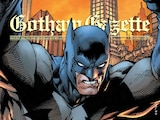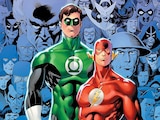It’s taken me a month to absorb the recent DC movies and TV announcement because…well, it was a lot, wasn’t it? In just a few info-packed minutes, DC Studios co-leader James Gunn unveiled the next ten projects coming down the pipeline for a grand, unified vision of the DC Universe across film, television and yet more media to come. It’s going to take a little time yet for the master plan to unfold. But as we like to say around here, in the meantime, there’s always comics.
Here’s what we are definitely not saying: these comics, barring a hilarious cosmic coincidence, are absolutely not going to be the literal beat-for-beat story basis of what’s to come. But I suspect they’ll do a decent job setting the tone for what I personally expect out of Gunn and Peter Safran’s upcoming efforts, and to maybe help you get a little more acquainted with what they’re going for. Think of this not as a literal blueprint for the future of DC Studios, but a mood board. Vibe check!
Frankenstein, Agent of S.H.A.D.E.
Creature Commandos feels like a surprising choice at first glance for this slate. But if you’re familiar with James Gunn’s work, it’s not surprising at all. From his early work at Troma to the chaotic violence of The Suicide Squad, monster movies and war stories are in his blood. The original Creature Commandos were created in 1980 by J.M. DeMatteis and Pat Broderick for the Weird War Tales anthology about an experimental military unit of monsters designed to strike fear into America’s enemies. For a more modern take on the concept, you’ll want to check out one of the more eclectic books of DC’s 2011 New 52 launch which placed Frankenstein front and center in this team of movie-inspired monsters. Yes, we mean the monster, not the doctor. They’re both named Frankenstein.
You could be forgiven for believing, at first glance, that Task Force X taskmaster Amanda Waller is a cold, heartless villain. But long-time followers of the character through the original Suicide Squad series by John Ostrander and Kim Yale know the truth of her, as one of the richest and most complicated characters in the DC Universe. As an outspoken fan of the run, going so far as to include Ostrander in The Suicide Squad, Gunn knows just as well as we do that “The Wall” is a lot more than she appears. As the focal point of the next live action series on HBO Max, you can get to know Waller before Waller through this explosive run where we learn her secret: that no one is truly expendable.
When we next see Superman on the big screen in Superman: Legacy, it’ll be a younger Man of Steel in the role than we’ve seen in quite some time. But for inspiration on the film’s tone, Legacy screenwriter Gunn has been quite open on where he’s drawing it: a story about the end of Superman’s career. All-Star Superman is Grant Morrison and Frank Quitely’s tale of Superman’s final days, giving humanity and the people he loves all he can before he has to leave them for good. That’s not going to be the story of Legacy—not for a cinematic universe just getting started—but it will inform what you can expect from our new Superman as a character: one who will give everything he can to make the world better and lift up the humanity he loves so dearly.
Don’t @ me on this, but Green Lantern: Earth One by Gabriel Hardman and Corrina Bechko was secretly the best book of DC’s entire Earth One line. From 2010 to 2021, DC’s Earth One graphic novels re-established the publisher’s flagship heroes in more modern, grounded settings for the 21st century. Geoff Johns and Gary Frank’s Batman: Earth One, for instance, formed much of the template for Matt Reeves’ The Batman. So, for a harder, more realistic look at the Green Lantern corner of the cosmos as the upcoming Lanterns series promises, there’s no better place to look than this duology which reframes Hal and John as relatively early space explorers who encounter a power unlike anything they’ve ever seen before. I have a feeling that Lanterns is going to feel the most like an entirely original story out of everything announced so far, but there’s got to be a reason they chose images from Hardman and Bechko’s Earth One books to tease it. Wondering why John Stewart seems to have a yellow ring? This is where you’ll find the answer.
This is another one I didn’t see coming at all on my end, but makes perfect sense from the guy who gave us the pitch black superhero comedy Super in 2010. An extreme superhero team harboring no qualms about violence or maintaining the status quo, the Authority was conceived as a more realistic take on what would happen if a team of super-powered, self-styled world protectors really existed in a world of conflicting interests and politics. This is just a guess on my part, but I suspect this one will R-rated. Once you read the original WildStorm series, you’ll have a good idea why.
Wonder Woman Historia: The Amazons
Here’s what we’ve been told about Paradise Lost—it’s Themyscira, Game of Thrones style. Drama, high fantasy, complex faction relations all in the centuries before Wonder Woman was shaped from clay or born from gods. There’s been a Wonder Woman arc in the past by that very same title, but what the premise here reminds me of most is the quite recent Wonder Woman Historia: The Amazons, Kelly Sue DeConnick’s chronicle of Amazonian history which frames the Themysciran saga with a feminine perspective on a historically male-dominated mythology. Add the fact that the series features three of the best artists in Wonder Woman history—Phil Jimenez, Gene Ha and Nicola Scott—delivering some of the greatest art of their careers and you’ve got a book that no Wonder Woman writer should omit from consultation ever again. Get to know the Amazon story, as told by Amazons.
Grant Morrison’s work through practically every major corner of the DC Universe over the past thirty years has been staggeringly influential on every writer to succeed them. So why shouldn’t that apply to the movies, too? The upcoming Brave and the Bold film will pair Batman with Damian Wayne on screen for the first time, taking heavy cues from Morrison’s epic Batman saga which redefined his world with one simple idea: everything is canon. With Gunn an outspoken lover of Bat-Mite, we wouldn’t be surprised to see a little Zur-En-Arrh action borrowing from Morrison’s early Batman RIP. But Morrison left their Batman tenure with a lot to play with. You’ll have to read the run for a full inventory of the toybox.
Before he was Blue Beetle’s knuckle-headed partner in mischief in “Justice League International,” Booster Gold was a hero for the social media age before social media really existed. In the wake of Crisis on Infinite Earths, Dan Jurgens created a brand new hero motivated, for once, by entirely selfish reasons with no pretense of altruism—a figure slotting right into the “me first” 1980s. It’s only in his quest for fame and fortune that Booster learns that there are some things worth fighting for bigger than himself. And that Booster, the one who struggles with what he’s really about despite his overtures at vapidity, is the one Gunn seems the most interested in exploring. I can’t guarantee that, as the cover above might suggest, early Booster Gold villain Blackguard will show up—we all saw what happened to him in The Suicide Squad—but you’ll get all of that Boosterrific flavor right here.
An instant classic, if that oxymoron can apply anywhere. In 2021, Tom King and Bilquis Evely gave us this space opera truly worthy of the Girl of Steel. Supergirl: Woman of Tomorrow proved Kara’s strength and resolve lightyears beyond the shadow of Superman, truly cementing Supergirl’s evolution from a perceived sidekick to a hero worthy of the A-List. It’s certainly a surprise that we’d get such a recent project as the basis for one of the next major DC films, but anyone who’s read it can’t deny what a great choice it is. Evely’s art is truly cinematic in its scope.
What I say now, I say whether you’ve read thousands of comics or none at all. If you’re going to read one comic book to teach you how the comic book medium can be used to its fullest potential, read Alan Moore’s Swamp Thing. It’s the book that inspired all your favorite comic book writers to be comic book writers, and it’s the bible for any great Swamp Thing project. (RIP, Swamp Thing ‘19.) Knowing James Gunn as a gory horror fan first and foremost, Swamp Thing was my personal first choice when we were all playing the guessing game over what he might be brewing at DC. I feel pretty good about my vindication here, and if you’d like to know why, just read it. Heck, just read issue #21, “The Anatomy Lesson,” and see if you don’t want to keep on reading through the night. You’ve got time. There’s always comics.
Alex Jaffe is the author of our monthly "Ask the Question" column and writes about TV, movies, comics and superhero history for DC.com. Follow him on Twitter at @AlexJaffe and find him in the DC Community as HubCityQuestion.
NOTE: The views and opinions expressed in this feature are solely those of Alex Jaffe and do not necessarily reflect those of DC Entertainment or Warner Bros.















